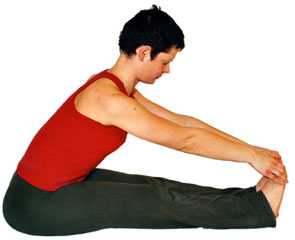

Paschimottanasana
«Paschimottanasana», more precisely «Pashchimottanasana», a simple «Sitting Forward Bend», called back stretching or «Pincer», is an Asana in Hatha Yoga. It is the 5th Asana of the 12 Basic Postures of the Yoga Vidya Series and develops devotion and patience. «Paschimottanasana» is a strong abdominal exercise in which the abdominal organs are stimulated and the digestion is harmonized. «Paschimottanasana» can be used in case of imminent colds, as it stimulates the immune system.
Table of Contents
1 General, Meaning and Symbolism
2 Effects of Pashchimottanasana
2.1 Physical Effects
2.2 Activated Joints
2.2.1 Stretched Muscles
2.2.2 Internal Organs
2.3 Mental Effects
2.4 Energetic Effects
2.5 Addressed Chakras
3 Swami Sivananda about Paschimottanasana
3.1 Method
3.2 Benefits
3.3 Furthermore
4 Execution of Paschimottanasana
5 Forward Bend, Sitting / One-Legged — Practical Instruction (Excerpt from a Complete Beginner Yoga Cours)
6 Further Information about the Forward Bend or Paschimottanasana
6.1 Paschimottanasana, Pashchimottanasana, Pascimottanasana or Pashimottanasana?
6.2 This or the Pashchimottanasana?
7 Sukadev about Pashchimottanasana
8 Preparatory Exercises for more Flexibility in the Forward Bends
9 Assistance in Paschimottanasana
10 Videos: Advanced Yoga Lessons
Paschimottanasana and Some Variations
Yoga Forward Bends
General, Meaning and Symbolism
➳Pashchima (pronounced: pash-chi-ma or pasch-tschi-ma) = sanskrit for behind, after, later, west.
➳Ottana = intensive stretching.
➳Thus pashchimottanasana means «Stretching of the West». In Ayurveda the back of the body is assigned to the west, because the «Sun Salutation» is traditionally performed with the face or the front of the body facing east towards the rising sun.
«Paschimottanasana» is the 5th Asana of the 12 Basic Postures of the Rishikesh Series, the Yoga-Vidya Basic Series and the Sivananda Basic Class.
Effects of Pashchimottanasana
Physical Effects
Activated Joints
Extension of the vertebral joints, flexion in the hip joint, extension in the knee joint, slight extension in the ankle joint, flexion in the shoulder joint, extension in the elbow joint, slight pronation of the forearm.
Stretched Muscles
➳Longissimus (long back extensor)
➳Trapezius inferior (lower trapezius muscle)
➳Latissimus dorsi (broad back muscle)
➳Gluteal muscles (fesses muscles)
➳Piriformis (pear-shaped muscle)
➳Obturator internus (inner hip hole muscle, turns the thigh outwards)
➳Bizeps femoris (two-headed thigh muscle)
➳Gastrocnemius (calf muscle)
➳Musculus soleus (plaice muscle)
Internal Organs
«Paschimottanasana» stimulates the kidneys and the liver and thus promotes the elimination of harmful substances from our body. In addition, if it is kept in for a longer period of time, it stimulates the pancreas, which on the one hand has a blood sugar lowering effect due to increased insulin secretion, and on the other hand an increased release of pancreatic enzymes results in better digestion. In addition, «Paschimottanasana» has the reputation of increasing the body's defenses. This observed phenomenon is probably due to a massage of the area of the intestine where the so-called peyer's plaques are located. Peyer's plaques are accumulations of defense cells mainly in the ileum and appendix.
Mental Effects
On a spiritual level, «Paschimottanasana» promotes the development of patience, devotion, humility, serenity and perseverance. The effect can be strengthened with affirmations such as: «I am patient», «I let go completely», «With perseverance and serenity I will reach my goal», and so on.
Energetic Effects
«Paschimottanasana» is one of the most energetically powerful Asanas, especially when practiced for a long time. «Paschimottanasana is one of the postures that can awaken the Kundalini in the advanced Yogi. All Chakras of the spinal column are activated and the subtle spinal column («Sushumna» also «Paschimottha Nadi») is opened. To strengthen the energetic effect, you can imagine how light energy collects in the «Muladhara Chakra» during the inhalation, which you then let rise up through the spine to the «Sahasrara Chakra» during the exhalation.
Addressed Chakras
«Paschimottanasana» activates all Chakras in the spine and harmonizes the solar plexus. Especially:
➳Muladhara Chakra
➳Swadhisthana Chakra
➳Manipura Chakra
➳Ajna Chakra
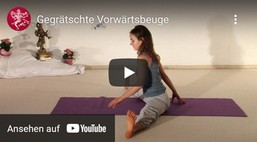
Swami Sivananda about Paschimottanasana
 «Niramla — turned Forward Bend»
«Niramla — turned Forward Bend»
Method
Sit on the floor and straighten your legs long and straight forward like a stick. Grip your toes with your thumb, index and middle finger. As you grasp, you will lean forward out of the torso. People who tend to be obese will find it relatively difficult to bend forward. Exhale and bend you forward without jerking movements until the forehead touches the knees. You can also keep your head between your knees. When you pull yourself down and forward, pull your belly backward (upward).
This makes the «Forward Bend» easier. Bend you slowly and gradually forward. Take all the time you need. There is no hurry. When you bend forward, put your head between your hands. Keep your head and hands at the same level. Young people with a flexible spine can touch their knees with their forehead on the very first try.
In the case of adults with quite immobile spine, it will take two weeks or a month to master this Asana successfully. Hold your breath until the forehead is back in its original position and you are sitting upright again. Stay in the posture for 5 seconds and gradually increase this time to 10 minutes. Those who find it difficult to perform «Paschimottanasana» completely can do it halfway with one leg and one hand and then with the other leg and hand.
They'll find this easier. After a few days, when the spine has become a little more flexible, you can try the full posture again. While practicing the Asana, you should use your common sense. Before you practice the Asana just described, read the instructions for «Janusirshasana».
Benefits
This is an excellent Asana. Practicing the Asana directs the breath through the «Brahma Nadi», the "Sushumna«, and ignites the fire of the stomach. This Asana reduces fat in the lower abdomen. This Asana is especially suitable for obesity or adipose and for enlargement of the liver and spleen. Books about Hatha Yoga praise this Asana. «Sarvangasana» stimulates the hormonal glands and «Paschimottanasana» is good for stimulating the internal abdominal organs such as kidneys, liver, pancreas and so on.
Practice increases the peristalsis of the bowels. Peristalsis refers to the worm-like movement of the intestines or bowels with which food and stool are pushed from one end of the bowel to the other. This Asana relieves constipation, removes sluggishness of the liver, digestive disorders, fecal burping and gastritis. Lumbago or a stiff back, all kinds of muscle pain and other illnesses can be cured. This Asana even cures hemorrhoids and diabetes.
The hip muscles of the lower abdomen, the solar plexus, the plexus of the upper abdomen, the bladder, nerves of the lumbar spine, the sympathetic plexus, all these areas are stimulated and thus kept in a healthy and reasonable state. Thanks to «Paschimottanasana», «Sirshasana» and «Sarvangasana», as well as to the «Rishis» which first passed on these wonderful Asanas to some students of Hatha Yoga. This section is taken from the book «Yoga Asanas» by Swami Sivananda Divine Life Society, Sivananda Ashram.
Furthermore
There is another way to do «Basti» without the help of water. This is called Sthula-Basti. Sit on the floor in «Paschimottanasana» and slowly roll through the regions of the abdomen and intestines with a downward movement. Tighten the anal sphincters. This removes constipation and all disorders in the abdominal area. However, it is not as effective as Jala-Basti.
This section is taken from the book «The Science of Pranayama» by Swami Sivananda Divine Life Society, Sivananda Ashram.
Execution of Paschimottanasana
Sit in the «Long Seat», hands next to the buttocks. Breathe in and straighten the spine completely, breathe out and pull the toes towards the knees. With the next inhalation straighten your arms vertically upwards. As you exhale, bend forward with your back straight and place your hands where they arrive (at the knee, shin, feet). Try to keep your back straight. If you can grasp your feet with your hands with your back straight, you can try to lay your upper body on your legs. Stay in this position for at least five deep breaths. To get out of the position, slowly straighten you up with the inhalation and straighten the arms far up again. Exhale and lower your arms. Go directly to «Purvottasana» («Inclined Plane») as «Counter Position».
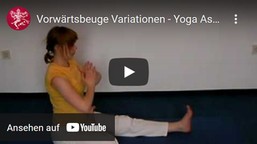
 |
 |
Forward Bend, Sitting / One-Legged — Practical Instruction (Excerpt from a Complete Beginner Yoga Cours)
In this Exercise Video Sukadev guides you to the «Sitting Forward Bend». This is an excerpt from the First Course Video of the 10-week Beginner Course http://mein.yoga-vidya.de/yoga-anfaengerkurs-video.
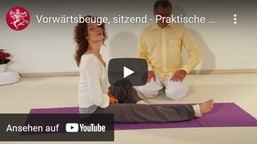
 |
 |
Further Information about the Forward Bend or Paschimottanasana
For more information about the «Forward Bend» or «Paschimottanasana» click here. In addition, there are many other Asanas that can enrich your practice schedule. You can find an overview here
.
Paschimottanasana, Pashchimottanasana, Pascimottanasana or Pashimottanasana?
There are different spellings for «Pashchimottanasana»: correct is in Sanskrit paścimottānāsana. There are different spellings in English, French and German that are commonly used, including Pashimottanasana, Pashchimottanasana, Pascimottanasana or Pashimottanasana, also Pashimottanaasana, Pashchimottanaasana, Pascimottanaasana or Pashimottanaasana. Hindi speakers also simply say or write Pashimottanasan, Pashchimottanasan, Pascimottanasan or Pashimottanasan. All these spellings refer to the same Asana, the same Yoga Posture.
This or the Pashchimottanasana?
From Sanskrit, «Pashchimottanasana» is a neutral. So it would be correct to say «This Pashchimottanasana». In German, the Yoga Postures are usually given a female gender, because it is called «The Yoga Posture». So it is usually said «The Pashchimottanasana». In the same way one can say «This Asana», which is correct from Sanskrit, or in German «The Asana». Finally, in literature one can find «This Pashchimottanasana» or also «The Pashchimottanasana». Pragmatically said: Both genders can be used.
Sukadev about Pashchimottanasana
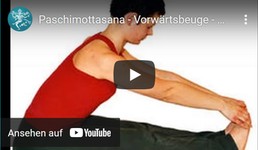
 |
 |
Preparatory Exercises for more Flexibility in the Forward Bends
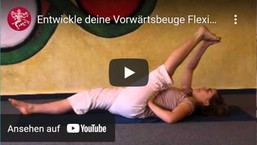
 |
 |
Assistance in Paschimottanasana
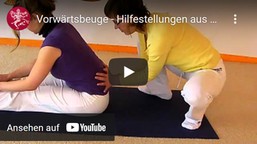
 |
 |
Videos Advanced Yoga Lessons
Yoga Forward Bends
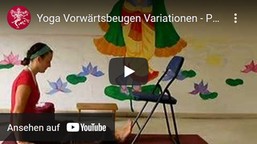
 |
 |

